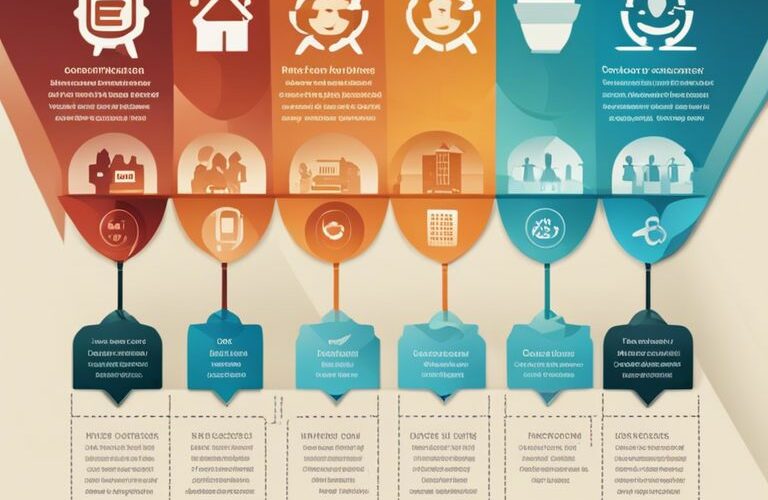Many businesses today understand the importance of Customer Lifecycle Management (CLM) in building long-term relationships with their customers. Having a strategic approach to managing the entire customer journey can significantly impact a company’s bottom line by increasing customer satisfaction, loyalty, and retention rates. In this comprehensive guide, we will explore the fundamentals of CLM and provide valuable insights on how businesses can effectively implement and leverage this powerful strategy.
Understanding the stages of the customer lifecycle – from acquisition to retention – is vital for creating personalized experiences that resonate with customers at each touchpoint. By tailoring marketing efforts, products, and services to meet the specific needs of customers in different phases of the lifecycle, businesses can maximize customer engagement and lifetime value. Our guide will probe into proven strategies and best practices for optimizing each stage of the customer journey to drive growth and profitability.
Moreover, we will discuss the challenges and pitfalls that companies may encounter when implementing CLM and provide expert tips on how to overcome them. From selecting the right technology platforms to measuring key performance indicators, this guide will equip businesses with the knowledge and tools needed to succeed in managing the customer lifecycle effectively. Stay tuned as we uncover the secrets to building lasting customer relationships and driving sustainable business growth through Customer Lifecycle Management.
Key Takeaways:
- Customer Lifecycle Management (CLM) is a strategic approach that focuses on building long-term relationships with customers.
- CLM helps businesses better understand their customers, anticipate their needs, and provide personalized experiences throughout their journey.
- There are five stages in the customer lifecycle: Reach, Acquisition, Conversion, Retention, and Loyalty.
- Personalization is key in CLM as it helps businesses tailor their interactions and offerings to meet the specific needs and preferences of customers.
- Data analysis plays a crucial role in CLM as it allows businesses to track customer behavior, measure the effectiveness of their strategies, and make data-driven decisions.
- Effective communication is necessary throughout the customer lifecycle to keep customers engaged, informed, and satisfied with the product or service.
- Continuous improvement is vital in CLM as businesses need to adapt and evolve their strategies to meet changing customer needs and market dynamics.
The Basics of Customer Lifecycle Management
It is crucial for businesses to understand and effectively manage their customer lifecycle to ensure long-term success and profitability. Customer Lifecycle Management (CLM) is a strategic approach that focuses on building strong relationships with customers throughout their entire journey with a company. By implementing CLM strategies, businesses can attract, retain, and delight customers at every stage of the lifecycle, leading to increased loyalty and lifetime value.
Definition of CLM
Customer Lifecycle Management (CLM) is a comprehensive framework that outlines the stages a customer goes through during their relationship with a company. These stages typically include awareness, acquisition, onboarding, engagement, retention, and advocacy. CLM involves the use of technology, data analysis, and personalized marketing strategies to deliver a seamless and cohesive experience for customers at each touchpoint.
Objectives of CLM
Management’s primary objective of Customer Lifecycle Management (CLM) is to guide customers through each stage of the journey in a way that maximizes their satisfaction and value to the business. By focusing on increasing customer lifetime value, CLM aims to nurture long-term relationships with customers, drive repeat purchases, and turn satisfied customers into brand advocates who actively promote the company to others.
While the specific objectives of CLM may vary depending on the industry and business goals, common goals include reducing customer churn, increasing customer loyalty, improving customer satisfaction, and boosting overall revenue. By proactively managing the customer lifecycle, businesses can identify opportunities for upselling, cross-selling, and personalized engagement, ultimately leading to improved customer retention and profitability.
Customer Lifecycle Management is an vital practice for businesses looking to thrive in today’s highly competitive market. By understanding the stages of the customer journey and implementing tailored strategies to address the needs and preferences of customers at each stage, companies can create a more personalized and engaging experience that sets them apart from the competition. Through effective CLM, businesses can build stronger, more profitable relationships with customers and drive long-term success.
Types of Customer Lifecycle Models
The customer lifecycle management (CLM) process is important for businesses looking to optimize their customer interactions and drive long-term loyalty. One crucial aspect of CLM is understanding the different types of customer lifecycle models that can be employed to segment and target customers effectively. By utilizing customer lifecycle models, businesses can tailor their marketing strategies and communication efforts to meet the specific needs and preferences of each customer segment.
Traditional Lifecycle Models
Any successful CLM strategy starts with understanding the traditional lifecycle models, such as the awareness, consideration, purchase, retention, and advocacy model. This model outlines the typical stages a customer goes through when interacting with a brand, from initial awareness to becoming a loyal advocate. By mapping out these stages, businesses can create targeted campaigns and personalized touchpoints to guide customers seamlessly through their journey. In a traditional customer lifecycle model, businesses focus on acquiring new customers, retaining them through exceptional service, and turning them into brand advocates who promote the product or service to others. By identifying pain points and opportunities at each stage of the customer journey, businesses can proactively address customer needs and build long-lasting relationships. Recognizing the value of each customer interaction is key to maximizing the lifetime value of a customer and driving sustainable growth.
Advanced Lifecycle Models
Any robust CLM strategy should also incorporate advanced lifecycle models, such as the predictive analytics-driven model, behavioral segmentation model, and customer lifetime value model. These models go beyond the traditional linear approach and take into account customer behaviors, preferences, and predictive metrics to anticipate future needs and drive personalized engagement. By leveraging advanced data analytics and machine learning algorithms, businesses can gain deeper insights into customer behavior and tailor their marketing efforts accordingly. Lifecycle models provide businesses with a holistic view of the customer journey and help identify opportunities for proactive engagement and personalized communication. Advanced lifecycle models enable businesses to segment customers based on behavior, preferences, and predictive metrics, allowing for highly targeted marketing campaigns and tailored experiences. By prioritizing customer retention and loyalty, businesses can increase customer lifetime value and drive sustainable growth in the long run.
- Reach: One of the key aspects of advanced lifecycle models is the ability to reach customers through personalized and targeted communication strategies. By segmenting customers based on behavior and preferences, businesses can deliver relevant content and offers that resonate with each customer segment.
- Engagement: Advanced lifecycle models enable businesses to increase customer engagement through personalized touchpoints and targeted communication efforts. By understanding customer behaviors and preferences, businesses can create tailored experiences that drive customer satisfaction and loyalty.
- Retention: By identifying at-risk customers and implementing targeted retention strategies, businesses can increase customer lifetime value and reduce churn rates. Advanced lifecycle models provide businesses with the insights and tools needed to keep customers engaged and loyal over time.
Factors Influencing Customer Lifecycle Management
Many factors influence Customer Lifecycle Management (CLM), impacting how businesses attract, engage, and retain customers throughout their journey. Understanding these factors is crucial for developing effective CLM strategies that drive growth and profitability.
Market Dynamics
An organization’s success in managing customer lifecycles is heavily influenced by market dynamics. Factors such as competition, industry trends, economic conditions, and regulatory changes can impact customer behavior and expectations. By staying attuned to these dynamics, businesses can adapt their CLM strategies to stay relevant and competitive in the market.
Consumer Behavior and Expectations
While market dynamics set the stage, consumer behavior and expectations dictate how businesses should interact with customers at each lifecycle stage. Understanding how customers research, purchase, and interact with brands can help businesses personalize their offerings and experiences to meet evolving expectations.
Plus, with the rise of digital channels and social media, customers now expect seamless, personalized interactions across all touchpoints. Businesses that fail to meet these expectations risk losing customers to competitors who excel at delivering relevant and engaging experiences.
The Role of Technology
Consumer technology plays a significant role in shaping CLM strategies. From data analytics and CRM systems to marketing automation and AI-powered personalization, technology enables businesses to track customer interactions, anticipate needs, and deliver targeted messaging throughout the customer journey.
With the right technology stack in place, businesses can create a seamless omnichannel experience that enhances customer satisfaction and loyalty. Leveraging technology effectively can also help businesses streamline internal processes, optimize resources, and drive operational efficiency.
Regulatory Environment
On the regulatory front, compliance with data protection laws and industry regulations is paramount in CLM. Businesses must ensure they collect, store, and use customer data in compliance with laws such as GDPR, CCPA, and industry-specific regulations. Failure to adhere to regulations can result in hefty fines, legal repercussions, and irreparable damage to brand reputation.
It’s crucial for businesses to stay informed about regulatory changes and implement robust data governance practices to safeguard customer data and maintain trust. By prioritizing compliance in their CLM strategies, businesses can build long-lasting relationships with customers based on transparency and respect for privacy.
Implementing Customer Lifecycle Management: A Step-by-Step Approach
Not every company realizes the importance of implementing a structured approach to managing the customer lifecycle. However, with the right strategy in place, businesses can significantly improve customer satisfaction, retention, and overall profitability. Implementing Customer Lifecycle Management (CLM) requires a systematic process that involves Initial Assessment and Goal Setting, Designing a Customer Lifecycle Management Strategy, Integration with Business Processes, and Success Metrics and KPIs.
Initial Assessment and Goal Setting
| Step | Description |
|---|---|
| Assess Current State | Analyze existing customer data, touchpoints, and feedback to understand where your company stands currently in managing the customer lifecycle. |
| Set Clear Goals | Define specific and measurable objectives for your CLM strategy, such as increasing customer retention rates, improving customer satisfaction scores, or boosting upsell opportunities. |
| Identify Key Stakeholders | Involve all relevant departments and team members in the goal-setting process to ensure alignment and collaboration across the organization. |
Designing a Customer Lifecycle Management Strategy
Setting up a robust CLM strategy involves creating a roadmap that outlines how you will engage with customers at each stage of their journey. Determine the key touchpoints, communication channels, and personalized experiences that will enhance the customer experience throughout the lifecycle. By segmenting customers based on behavior, preferences, and needs, you can tailor your interactions to deliver relevant and timely messaging.
Customer segmentation is necessary for designing a successful CLM strategy. By categorizing customers into distinct groups, you can create targeted campaigns that resonate with their unique characteristics. Leverage data analytics and customer insights to understand what drives each segment and how you can best cater to their needs. Personalizing the customer experience will foster loyalty and drive repeat business.
Integration with Business Processes
| Step | Description |
|---|---|
| Align with Sales and Marketing | Ensure seamless coordination between sales, marketing, and customer service teams to deliver a cohesive customer experience across all touchpoints. |
| Integrate Technology Platforms | Invest in CRM and automation tools that can centralize customer data, automate workflows, and facilitate personalized interactions at scale. |
| Train Employees | Provide training and resources for employees to understand the CLM strategy and their role in executing it effectively. Empower staff to deliver exceptional service at every customer interaction. |
Success Metrics and KPIs
Interactions with customers at each stage of the lifecycle should be data-driven to measure the effectiveness of your CLM strategy. Define key performance indicators (KPIs) that align with your goals, such as customer lifetime value, churn rates, or Net Promoter Score. Regularly monitor these metrics to track progress, identify areas for improvement, and make data-driven decisions to enhance customer relationships.
Integration of success metrics and KPIs into your overall business strategy will help demonstrate the impact of CLM on key business outcomes. By quantifying the value generated through improved customer relationships, businesses can justify investments in customer-centric initiatives and continually optimize their CLM strategy for long-term success.
Tips for Effective Customer Lifecycle Management
Unlike traditional marketing approaches, Customer Lifecycle Management (CLM) requires a strategic and tailored approach to engage customers at every stage of their journey with your brand. To effectively manage the customer lifecycle and drive positive outcomes, organizations must consider a few key tips:
- Align CLM with Company Vision and Culture: The success of your CLM initiatives depends on how well they align with your company’s vision and culture. It’s crucial to ensure that your CLM strategies reflect the values and goals of your organization. By integrating CLM into your company’s DNA, you can create a seamless and consistent experience for your customers.
Aligning CLM with Company Vision and Culture
The alignment of CLM with your company’s vision and culture is imperative for creating a unified customer experience. By embedding CLM practices into your organizational culture and ensuring they are in line with your company’s overarching goals, you can foster stronger customer relationships and drive long-term loyalty. This alignment also helps in building a cohesive brand identity that resonates with customers at every touchpoint.
Moreover, when CLM is integrated into the core values of your organization, it becomes easier to implement strategies that prioritize customer satisfaction and retention. By making CLM a central focus of your company’s vision, you can ensure that every decision and action taken aligns with the goal of enhancing the customer experience and maximizing customer lifetime value.
Knowing that your CLM strategies are in harmony with your company’s vision and culture not only strengthens customer relationships but also sets the foundation for sustainable growth and success in the long run.
Data Analysis and Insight Generation
Vision
Aligning
Communicating with Customers
Analysis
For instance
Continuous Improvement and Innovation
Communicating
Company
Leveraging Technology in CLM
Customer Relationship Management (CRM) Software
You cannot underestimate the importance of Customer Relationship Management (CRM) software in customer lifecycle management. It is the cornerstone of your CLM strategy and helps you track, manage, and analyze customer interactions throughout their journey with your brand. By centralizing customer data, CRM software enables you to create personalized experiences, tailor communication, and retain loyal customers. With features like lead management, contact management, and sales automation, CRM software streamlines processes and enhances customer satisfaction.
When choosing a CRM solution, look for one that integrates seamlessly with your other business systems, offers robust reporting capabilities, and provides scalability for future growth. CRM software empowers your teams to collaborate effectively, gain insights into customer behavior, and make data-driven decisions that drive revenue and customer retention.
By leveraging CRM software in your CLM strategy, you can enhance customer engagement, improve operational efficiency, and boost overall business performance. It allows you to build stronger relationships with your customers, anticipate their needs, and deliver exceptional experiences at every touchpoint.
Marketing Automation
Clearly, marketing automation plays a crucial role in optimizing customer interactions and streamlining marketing efforts throughout the customer lifecycle. It enables you to automate repetitive tasks, personalize communication, and nurture leads effectively. With features like email marketing, lead scoring, and workflow automation, marketing automation tools help you deliver the right message at the right time to the right audience.
Marketing automation platforms simplify campaign management, improve targeting precision, and provide valuable insights into customer behavior. They allow you to create dynamic customer journeys, track performance metrics, and refine strategies for better results. By automating manual processes and leveraging data-driven insights, marketing automation enhances customer engagement and drives conversions.
Marketing automation is a powerful tool that empowers marketers to create more efficient, personalized, and impactful campaigns. It enables you to nurture leads, improve customer segmentation, and optimize marketing ROI. By automating tasks and workflows, marketing automation tools free up valuable time and resources, allowing your team to focus on strategic initiatives and creative endeavors.
Analytics and Data Management Tools
Technology is constantly evolving, and Analytics and Data Management Tools are necessary components of customer lifecycle management in the digital age. These tools enable you to collect, analyze, and interpret customer data to gain valuable insights into their behavior, preferences, and purchase patterns. By leveraging advanced analytics tools, you can track key performance indicators, monitor campaign effectiveness, and optimize your CLM strategy for maximum impact.
Management of customer data is crucial for personalized marketing efforts and targeted campaigns. Analytics and Data Management Tools help you segment your audience, create tailored messages, and deliver relevant content that resonates with your customers. By harnessing the power of data analytics, you can make informed decisions, drive customer engagement, and improve overall customer satisfaction.
Automation of data management processes streamlines workflow, reduces manual errors, and ensures data accuracy. Analytics and Data Management Tools enable you to centralize customer information, maintain data hygiene, and comply with data privacy regulations. By investing in robust analytics and data management solutions, you can unlock the full potential of your customer data and drive sustainable business growth.
Omnichannel Strategies
The omnichannel strategies encompass all customer touchpoints, ensuring a seamless and consistent experience across various channels. By integrating multiple channels such as social media, email, website, and physical stores, you can engage customers more effectively and drive loyalty. Omnichannel strategies enable you to reach customers where they are, deliver personalized experiences, and foster long-term relationships.
Leveraging omnichannel strategies allows you to create a unified brand presence, tailor messaging for different channels, and provide a cohesive customer journey. By analyzing customer interactions across channels, you can understand their preferences, behavior, and engagement patterns. Implementing omnichannel strategies enhances customer satisfaction, increases brand loyalty, and drives revenue growth.
With omnichannel strategies, you can cultivate a consistent brand image, deliver relevant content, and optimize customer engagement at every touchpoint. By connecting the dots between online and offline channels, you can create a holistic customer experience that resonates with your audience. Embracing omnichannel strategies in your CLM approach empowers you to understand customer behavior, personalize interactions, and differentiate your brand in a competitive marketplace.
Pros and Cons of Customer Lifecycle Management
Now, let’s take a closer look at the advantages and disadvantages of implementing a Customer Lifecycle Management (CLM) strategy.
| Advantages | Challenges |
| – Improves customer retention | – Requires substantial initial investment |
| – Enhances customer satisfaction | – Data management and analysis can be complex |
| – Helps in understanding customer behavior | – Integration with existing systems can be challenging |
| – Increases cross-selling and upselling opportunities | – Continuous monitoring and updating needed |
| – Enables personalized marketing campaigns | – Requires a skilled team to manage effectively |
Advantages of Effective CLM
Some of the key advantages of implementing an effective Customer Lifecycle Management strategy include improving customer retention rates, enhancing customer satisfaction, and gaining insights into customer behavior. By effectively managing the customer lifecycle, businesses can identify opportunities to increase cross-selling and upselling, as well as create personalized marketing campaigns that resonate with their target audience. These benefits can ultimately lead to increased revenue and long-term customer loyalty. Furthermore, a well-executed CLM strategy helps businesses build stronger relationships with their customers by providing customized experiences based on their needs and preferences. By leveraging data and analytics, companies can anticipate customer needs and proactively address any issues that may arise during the customer journey. This level of personalization can set businesses apart from their competitors and create a unique selling proposition that resonates with customers. Moreover, a robust CLM strategy can streamline business processes and improve overall efficiency by automating repetitive tasks and standardizing customer interactions. By implementing a coherent and consistent approach to managing the customer lifecycle, businesses can ensure a seamless experience across all touchpoints, leading to higher customer satisfaction and brand advocacy.
Challenges and Limitations
With any strategy, there are also challenges and limitations to consider when implementing Customer Lifecycle Management. Some of the key challenges include the substantial initial investment required to set up a CLM system, the complexity of data management and analysis, and the integration of CLM with existing systems. Additionally, maintaining a CLM strategy requires continuous monitoring and updating to stay relevant and effective, as customer preferences and market trends evolve over time. Reputation Management: It is crucial for businesses to carefully manage their reputation when implementing a CLM strategy. One negative customer experience or data breach can tarnish a company’s image and impact its bottom line. On the flip side, a positive reputation built on personalized and attentive customer service can lead to increased customer trust and loyalty, ultimately driving business growth and success. It is crucial for businesses to prioritize reputation management as a central component of their CLM strategy to build a strong and resilient brand in the long run.
Industry Perspectives on CLM
Best Practices Across Various Industries
Now, Customer Lifecycle Management (CLM) is a crucial aspect of business strategy across various industries. The best practices for CLM differ based on the nature of the industry. In the retail sector, personalized product recommendations based on customer purchase history and preferences can significantly enhance customer engagement and retention. On the other hand, in the healthcare industry, effective CLM involves proactive patient outreach to ensure continuity of care and patient satisfaction.
Implementing automation tools for customer interactions can streamline processes and improve efficiency in industries like banking and finance. By leveraging data analytics and customer behavior insights, organizations can anticipate needs and tailor offerings to meet customer expectations. In the tech industry, agile CLM practices that focus on continuous improvement and innovation are key to staying ahead in a rapidly evolving market.
For example, in the hospitality sector, utilizing CLM to create personalized guest experiences can lead to increased loyalty and positive word-of-mouth referrals. By integrating feedback loops and real-time communication channels, businesses can address customer needs promptly and effectively, setting them apart from competitors.
Innovations in CLM Approaches
Clearly, innovations in CLM approaches are reshaping the way businesses interact with their customers. Emerging technologies such as artificial intelligence and machine learning are revolutionizing customer engagement by enabling predictive analytics and personalized marketing automation. By harnessing the power of data-driven insights, organizations can drive targeted campaigns and improve customer retention rates.
Across industries, the integration of omnichannel communication strategies is becoming increasingly prevalent in CLM. This approach allows businesses to maintain consistent messaging and seamless customer experiences across multiple touchpoints, from social media platforms to email marketing campaigns. By creating a unified customer journey, companies can build stronger relationships with their customers and foster brand advocacy.
Adapting CLM to Different Market Segments
Market segmentation plays a vital role in adapting CLM strategies to meet the diverse needs of customers. By customizing messaging and offerings based on demographic, behavioral, or psychographic factors, businesses can create more targeted and relevant customer experiences. In the automotive industry, for instance, CLM can involve personalized vehicle recommendations and tailored service packages based on the customer’s driving habits and preferences.
For instance, in the healthcare sector, CLM approaches may vary for different patient segments, such as pediatric care versus geriatric care. By understanding the unique needs and preferences of each market segment, healthcare providers can deliver personalized care plans and enhance patient satisfaction. Adapting CLM strategies to different market segments allows organizations to build lasting relationships with customers and drive long-term success.
The Ultimate Guide To Customer Lifecycle Management (CLM)
Predictive Analytics and CLM
Despite the advances made in Customer Lifecycle Management (CLM) strategies, the future holds even more promising developments with the integration of predictive analytics. There’s a significant shift towards using data-driven insights to anticipate customer behavior and needs throughout their journey. By leveraging predictive analytics, companies can forecast trends, identify potential churn risks, tailor personalized offers, and ultimately enhance overall customer experience.
There’s no denying the profound impact of AI and Machine Learning on Customer Lifecycle Management. These technologies have revolutionized how businesses understand, engage, and retain their customers. AI-powered algorithms can analyze vast amounts of data to provide real-time insights, automate marketing campaigns, and deliver hyper-personalized experiences at scale.
The Impact of AI and Machine Learning
Customer segmentation, predictive analytics, dynamic pricing, and recommendation engines are just a few examples of how AI and Machine Learning transform Customer Lifecycle Management. These technologies enable companies to increase customer retention rates, improve cross-selling and upselling opportunities, and drive revenue growth through personalized interactions.
Personalization at Scale
Machine learning algorithms play a crucial role in achieving personalization at scale within Customer Lifecycle Management. By analyzing customer behavior, preferences, and historical data, businesses can create tailored marketing strategies, product recommendations, and communication channels. This level of personalization not only enhances customer satisfaction but also builds long-term loyalty and advocacy.
Predictive analytics further enhance personalization at scale by anticipating customer needs and preferences before they are explicitly expressed. By proactively addressing customer requirements, businesses can deliver relevant content, offers, and solutions that resonate with each individual, fostering deeper connections and driving conversions.
Final Words
So, we have reached the end of the Ultimate Guide to Customer Lifecycle Management (CLM). Throughout this comprehensive guide, we have explored the key stages of the customer lifecycle, from acquisition to retention, and discussed the strategies and tools you can implement at each stage to optimize customer relationships and drive business growth. By understanding the customer journey and tailoring your approach to meet their needs at every touchpoint, you can build long-lasting relationships and maximize customer lifetime value.
Implementing a robust CLM strategy is important for any business looking to stay competitive in today’s market. By leveraging data, personalization, automation, and feedback loops, you can create a seamless and personalized customer experience that sets you apart from the competition. Keep in mind, customer lifecycle management is an ongoing process that requires continuous monitoring, analysis, and adjustment to stay agile and responsive to changing customer needs and market trends.
By mastering the art of customer lifecycle management, you can not only drive revenue and growth but also build a loyal customer base that will advocate for your brand and drive future business success. So, take the insights and strategies from this guide and start applying them to your own customer lifecycle management approach today. Your customers will thank you, and your business will thrive as a result.
FAQ
Q: What is Customer Lifecycle Management (CLM)?
A: Customer Lifecycle Management (CLM) is a strategic approach that focuses on managing a customer’s journey from the initial purchase of a product or service to customer retention and loyalty.
Q: Why is Customer Lifecycle Management important for businesses?
A: CLM is important for businesses as it helps in understanding customer needs and preferences at each stage of their journey, enabling personalized communication and increasing customer satisfaction and loyalty.
Q: What are the key stages of the Customer Lifecycle?
A: The key stages of the Customer Lifecycle include awareness, consideration, purchase, retention, and advocacy. These stages help businesses effectively engage with customers throughout their journey.
Q: How can businesses benefit from implementing Customer Lifecycle Management strategies?
A: By implementing CLM strategies, businesses can improve customer retention, increase customer lifetime value, enhance customer satisfaction, and drive business growth through repeat purchases and referrals.
Q: What are some best practices for implementing Customer Lifecycle Management?
A: Best practices for implementing CLM include using data analytics to understand customer behavior, segmenting customers based on their lifecycle stage, personalizing communication, providing excellent customer service, and continuously optimizing strategies based on feedback and results.
Q: How can businesses measure the success of their Customer Lifecycle Management efforts?
A: Businesses can measure the success of their CLM efforts through key performance indicators (KPIs) such as customer retention rate, customer satisfaction score, customer lifetime value, repeat purchase rate, and Net Promoter Score (NPS).
Q: What are some tools and technologies that can help businesses in managing the Customer Lifecycle?
A: There are various tools and technologies available for businesses to manage the Customer Lifecycle effectively, including customer relationship management (CRM) software, marketing automation platforms, data analytics tools, and customer feedback management systems.


![10 Best Software Reseller Programs [2025]](https://smartgeekguide.com/wp-content/uploads/2025/01/10-best-software-reseller-programs-2025-mps-360x240.jpg)






